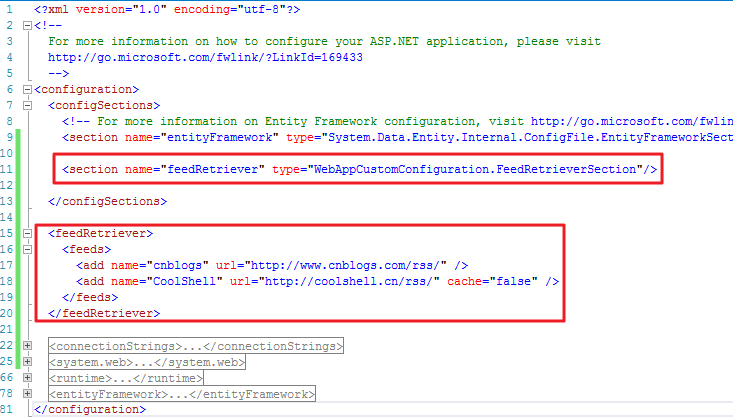.NET Framework在web.config或app.config中默认提供了很多种设置,以便能够改变应用程序内嵌组件的行为,例如<connectionStrings>、<httpHandlers>、<sessionState>等等,这对于常规情况下的一般程序员而言是足够用的,也是非常方便的。但是我们越来越多地发现需要自己来控制一系列设置的集合 - 有时是面向组件的(自定义的或第三方提供的),有时是应用程序中使用的一系列值的集合。
.config虽然默认提供了自定义设置(在<appSettings/>节点下),但是它太弱了,仅仅只支持键值对(key/value)
<add key="myKey" value="myValue"/>
虽然键值对在大多数情况下也是很有帮助的,但是它对于健壮的组件、复杂的设置而言是不够灵活的,甚至显得过于简单。幸运的是,微软为我们提供了一种以编程的方式来访问自定义的配置/设置。
一、The Configuration Section
先看如下的配置设置,含义很明确:定义一些rss,有名字、地址、以及是否缓存
<feedRetriever> <feeds> <add name="cnblogs" url="http://www.cnblogs.com/rss/" /> <add name="CoolShell" url="http://coolshell.cn/rss/" cache="false" /> </feeds> </feedRetriever>
接下来我们就以代码来展示如何调用
二、Writing the Configuration Handler
<add/> Element每一个ConfigurationElement对象都是作为其内部属性(properties)集合的索引器而存在,再通过.NET提供了另一个属性(Attribute)-- 从而使得<add/>(.config中的自定义节点,取名add完全是基于微软是如此命名故为保持一致而为之)节点的attributes与FeedElement的properties进行关联(map),具体代码如下
using System; using System.Collections.Generic; using System.Configuration; using System.Linq; using System.Web; namespace WebAppCustomConfiguration { public class FeedElement : ConfigurationElement { [ConfigurationProperty("name", IsKey = true, IsRequired = true)] public string Name { get { return (string)this["name"]; } set { } } [ConfigurationProperty("url", IsRequired = true, DefaultValue = "http://localhost")] [RegexStringValidator(@"http?\://\S+")] public string Url { get { return (string)this["url"]; } set { } } [ConfigurationProperty("cache", IsRequired = false, DefaultValue = true)] public bool Cache { get { return (bool)this["cache"]; } set { } } } }
The following list is a complete list of possible parameters:
类ConfigurationElementCollection包含有好几个成员,但是只有两个标记为abstract,所以最简单的ConfigurationElementCollection只需实现这两个方法
using System; using System.Collections.Generic; using System.Configuration; using System.Linq; using System.Web; namespace WebAppCustomConfiguration { [ConfigurationCollection(typeof(FeedElement))] public class FeedElementCollection : ConfigurationElementCollection { protected override ConfigurationElement CreateNewElement() { return new FeedElement(); } protected override object GetElementKey(ConfigurationElement element) { return ((FeedElement)element).Name; } } }
此Class较为简单,只需编程实现能够访问<feeds />节点即可,具体而言就是一属性(Property)
using System; using System.Collections.Generic; using System.Configuration; using System.Linq; using System.Web; namespace WebAppCustomConfiguration { public class FeedRetrieverSection : ConfigurationSection { [ConfigurationProperty("feeds", IsDefaultCollection = true)] public FeedElementCollection Feeds { get { return (FeedElementCollection)this["feeds"]; } set { } } } }
下面的配置就不说了
<section name="feedRetriever" type="WebAppCustomConfiguration.FeedRetrieverSection"/>

调用的代码如下,简单不解释
using System; using System.Collections.Generic; using System.Configuration; using System.IO; using System.Linq; using System.Net; using System.Web; namespace WebAppCustomConfiguration { public class FeedRetriever { public static FeedRetrieverSection _Config = ConfigurationManager.GetSection("feedRetriever") as FeedRetrieverSection; public static void GetFeeds() { foreach (FeedElement feedElement in _Config.Feeds) { // make request HttpWebRequest request = (HttpWebRequest)WebRequest.Create(feedElement.Url); WebProxy proxy = new WebProxy("ip address:port", true); proxy.Credentials = new NetworkCredential("username", "password", "domain"); request.Proxy = proxy; HttpWebResponse response = (HttpWebResponse)request.GetResponse(); if (response.StatusCode == HttpStatusCode.OK) { string feedData = String.Empty; using (StreamReader reader = new StreamReader(response.GetResponseStream())) { feedData = reader.ReadToEnd(); } if (feedElement.Cache) { // filename of cache file string filename = String.Format("{0}_{1}.xml", feedElement.Name, DateTime.Now.Ticks); // cache file using (StreamWriter writer = new StreamWriter(@"D:\Deployment\Result\" + filename)) { writer.Write(feedData); } } } } } } }